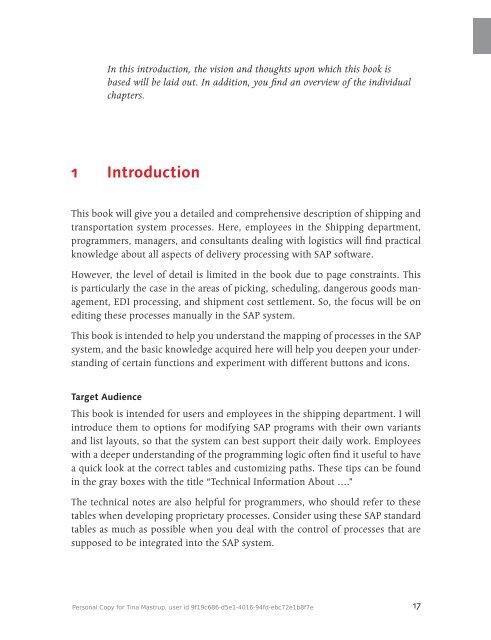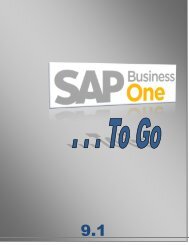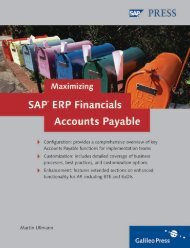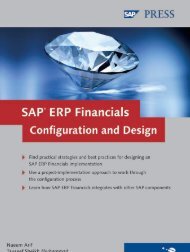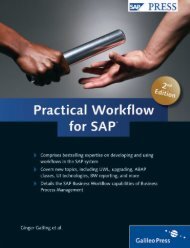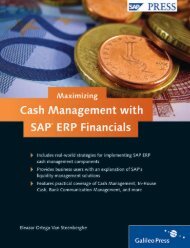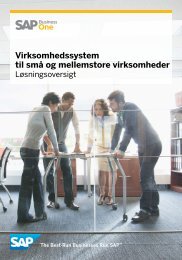- Page 2 and 3: SAP PRESS is a joint initiative of
- Page 5 and 6: Notes on Usage This e-book is prote
- Page 7 and 8: Contents 1 Introduction ...........
- Page 9 and 10: Contents 5.6.1 Transportation Zones
- Page 11 and 12: Contents 7.5.1 Creating a Delivery
- Page 13 and 14: Contents 11 Status Tracking .......
- Page 15: Contents 16.4 Errors in EDI Outputs
- Page 19 and 20: Introduction 1 ferent options for c
- Page 21 and 22: Introduction 1 (for example, how to
- Page 23 and 24: Organizational structures in the SA
- Page 25 and 26: Logistic Organizational Structures
- Page 27 and 28: Logistic Organizational Structures
- Page 29 and 30: Logistic Organizational Structures
- Page 31 and 32: Logistic Organizational Structures
- Page 33 and 34: Warehouse-Related Organizational St
- Page 35 and 36: Warehouse-Related Organizational St
- Page 37 and 38: Organizational Structures in Sales
- Page 39 and 40: Organizational Structures in Sales
- Page 41 and 42: Organizational Structures in Sales
- Page 43 and 44: Master data ensures that logistics
- Page 45 and 46: Material Master Data 3.1 For each m
- Page 47 and 48: Material Master Data 3.1 Figure 3.3
- Page 49 and 50: Material Master Data 3.1 If you hav
- Page 51 and 52: Customer Master Data 3.2 EE EE EE C
- Page 53 and 54: Customer Master Data 3.2 The ship-t
- Page 55 and 56: Customer Master Data 3.2 Figure 3.1
- Page 57 and 58: Batch Master Data 3.4 Figure 3.13 A
- Page 59 and 60: Dangerous Goods Master Data 3.5 Tra
- Page 61 and 62: Summary 3.6 information, and aggreg
- Page 63 and 64: This chapter familiarizes you with
- Page 65 and 66: Sales Orders 4.1 Document Types As
- Page 67 and 68:
Sales Orders 4.1 Sales Order Header
- Page 69 and 70:
Sales Orders 4.1 EE EE EE EE Immedi
- Page 71 and 72:
Sales Orders 4.1 Technical Informat
- Page 73 and 74:
Sales Orders 4.1 EE EE EE EE Delive
- Page 75 and 76:
Sales Orders 4.1 point of view, the
- Page 77 and 78:
Sales Orders 4.1 Now save the stand
- Page 79 and 80:
Sales Orders 4.1 EE EE EE Shipping
- Page 81 and 82:
Sales Orders 4.1 EE your own inform
- Page 83 and 84:
Sales Orders 4.1 Standard Order Inv
- Page 85 and 86:
Sales Orders 4.1 Figure 4.15 illust
- Page 87 and 88:
Sales Orders 4.1 However, a deliver
- Page 89 and 90:
Sales Orders 4.1 Figure 4.19 Schedu
- Page 91 and 92:
Sales Orders 4.1 However, if you wi
- Page 93 and 94:
Purchase Orders 4.2 Before the two
- Page 95 and 96:
Purchase Orders 4.2 Traditional Pur
- Page 97 and 98:
Purchase Orders 4.2 Technical Infor
- Page 99 and 100:
Purchase Orders 4.2 Example of a St
- Page 101 and 102:
Summary 4.3 However, if the plants
- Page 103 and 104:
This chapter describes the structur
- Page 105 and 106:
Task and Structure of the Delivery
- Page 107 and 108:
Delivery Types and Item Categories
- Page 109 and 110:
Delivery Types and Item Categories
- Page 111 and 112:
Delivery Types and Item Categories
- Page 113 and 114:
Delivery Types and Item Categories
- Page 115 and 116:
Creating Deliveries 5.3 Technical I
- Page 117 and 118:
Creating Deliveries 5.3 EE EE EE EE
- Page 119 and 120:
Creating Deliveries 5.3 Figure 5.18
- Page 121 and 122:
Creating Deliveries 5.3 Figure 5.23
- Page 123 and 124:
Creating Deliveries 5.3 E E “1”
- Page 125 and 126:
Creating Deliveries 5.3 For testing
- Page 127 and 128:
Creating Deliveries 5.3 After that,
- Page 129 and 130:
Creating Deliveries 5.3 Figure 5.34
- Page 131 and 132:
Creating Deliveries 5.3 Figure 5.37
- Page 133 and 134:
Creating Deliveries 5.3 Further Sel
- Page 135 and 136:
Creating Deliveries 5.3 3. In anoth
- Page 137 and 138:
Creating Deliveries 5.3 Figure 5.45
- Page 139 and 140:
Copy Control 5.4 Copy Control for D
- Page 141 and 142:
Copy Control 5.4 ment is permitted.
- Page 143 and 144:
Shipping Point 5.5 Company Code OG0
- Page 145 and 146:
Shipping Point 5.5 Technical Inform
- Page 147 and 148:
Shipping Point 5.5 Figure 5.56 Cust
- Page 149 and 150:
Routes 5.6 3. A screen as the one s
- Page 151 and 152:
Routes 5.6 copied into the delivery
- Page 153 and 154:
Routes 5.6 Figure 5.63 Transport Gr
- Page 155 and 156:
Routes 5.6 For the initial creation
- Page 157 and 158:
Routes 5.6 3. Enter the country and
- Page 159 and 160:
Goods Receiving Points 5.7 Figure 5
- Page 161 and 162:
Goods Receiving Points 5.7 Figure 5
- Page 163 and 164:
Availability Check 5.8 5.8.2 Types
- Page 165 and 166:
Availability Check 5.8 material cou
- Page 167 and 168:
Availability Check 5.8 5.8.5 Sample
- Page 169 and 170:
Availability Check 5.8 ATP Availabi
- Page 171 and 172:
Delivery Combination, Delivery Spli
- Page 173 and 174:
Delivery Combination, Delivery Spli
- Page 175 and 176:
Summary 5.10 warehouse number ident
- Page 177 and 178:
The delivery document contains info
- Page 179 and 180:
Scheduling 6.1 Order Date Material
- Page 181 and 182:
Scheduling 6.1 Technical Informatio
- Page 183 and 184:
Scheduling 6.1 The settings for tra
- Page 185 and 186:
Incompletion Check 6.2 You have see
- Page 187 and 188:
Incompletion Check 6.2 EE Pack If y
- Page 189 and 190:
Incompletion Check 6.2 This example
- Page 191 and 192:
Partner Determination 6.3 SAP syste
- Page 193 and 194:
Texts in the Delivery Document 6.4
- Page 195 and 196:
Texts in the Delivery Document 6.4
- Page 197 and 198:
Texts in the Delivery Document 6.4
- Page 199 and 200:
Texts in the Delivery Document 6.4
- Page 201 and 202:
Texts in the Delivery Document 6.4
- Page 203 and 204:
Export Data 6.5 6.5.1 Export Data i
- Page 205 and 206:
Export Data 6.5 Figure 6.30 Origina
- Page 207 and 208:
Batches 6.6 Figure 6.32 Export Cont
- Page 209 and 210:
Batches 6.6 6.6.3 Time of Batch Det
- Page 211 and 212:
Batches 6.6 Figure 6.34 Creating an
- Page 213 and 214:
Batches 6.6 Technical Information A
- Page 215 and 216:
Batches 6.6 6.6.5 Selection Criteri
- Page 217 and 218:
Batches 6.6 tion set up with the cu
- Page 219 and 220:
Batches 6.6 Figure 6.46 Sales Order
- Page 221 and 222:
Batches 6.6 Figure 6.50 Log for Bat
- Page 223 and 224:
Batches 6.6 Close the pop-up. If yo
- Page 225 and 226:
Serial Numbers 6.7 Serial number ma
- Page 227 and 228:
Serial Numbers 6.7 Transaction code
- Page 229 and 230:
Registration, Means of Transportati
- Page 231 and 232:
Registration, Means of Transportati
- Page 233 and 234:
Summary 6.9 Figure 6.64 Overview of
- Page 235 and 236:
After you create the delivery docum
- Page 237 and 238:
Picking Goods 7.1 Picking Storage L
- Page 239 and 240:
Picking Goods 7.1 Figure 7.4 shows
- Page 241 and 242:
Picking Goods 7.1 7.1.6 Condition f
- Page 243 and 244:
Picking Goods 7.1 Figure 7.6 Enteri
- Page 245 and 246:
Door, Staging Area, and Loading Poi
- Page 247 and 248:
Door, Staging Area, and Loading Poi
- Page 249 and 250:
Door, Staging Area, and Loading Poi
- Page 251 and 252:
Overdeliveries and Underdeliveries
- Page 253 and 254:
Overdeliveries and Underdeliveries
- Page 255 and 256:
Lean WM 7.4 you try to obtain infor
- Page 257 and 258:
Lean WM 7.4 Some storage types in l
- Page 259 and 260:
Lean WM 7.4 consider these differen
- Page 261 and 262:
Lean WM 7.4 7.4.2 Picking Lists In
- Page 263 and 264:
Lean WM 7.4 The first parameter dep
- Page 265 and 266:
Lean WM 7.4 Second, you must still
- Page 267 and 268:
Lean WM 7.4 Figure 7.27 Creation of
- Page 269 and 270:
Lean WM 7.4 Figure 7.31 Status in D
- Page 271 and 272:
Lean WM 7.4 Capturing Batches in th
- Page 273 and 274:
Wave Picks 7.5 After you save, the
- Page 275 and 276:
Wave Picks 7.5 1. Creation of a wav
- Page 277 and 278:
Wave Picks 7.5 3. Because you will
- Page 279 and 280:
Wave Picks 7.5 You can display the
- Page 281 and 282:
To transport materials safely, you
- Page 283 and 284:
Packing Prerequisites 8.1 Figure 8.
- Page 285 and 286:
Packing Prerequisites 8.1 IF VBUK-C
- Page 287 and 288:
Packing Prerequisites 8.1 The param
- Page 289 and 290:
Packing Prerequisites 8.1 Figure 8.
- Page 291 and 292:
Manual Packing 8.2 Technical Inform
- Page 293 and 294:
Manual Packing 8.2 Figure 8.13 Pack
- Page 295 and 296:
Manual Packing 8.2 Figure 8.17 Pop-
- Page 297 and 298:
Manual Packing 8.2 The system has n
- Page 299 and 300:
Manual Packing 8.2 Figure 8.24), en
- Page 301 and 302:
Inventory-Managed Packing 8.3 If yo
- Page 303 and 304:
Inventory-Managed Packing 8.3 8.3.2
- Page 305 and 306:
Packing Proposal 8.4 You now have t
- Page 307 and 308:
Packing Proposal 8.4 If you have de
- Page 309 and 310:
Packing Proposal 8.4 EE EE Specific
- Page 311 and 312:
Packing Proposal 8.4 If you run the
- Page 313 and 314:
Packing Proposal 8.4 Select your co
- Page 315 and 316:
Summary 8.6 If you know the SSCC nu
- Page 317 and 318:
You must adhere to legal requiremen
- Page 319 and 320:
Dangerous Goods Master Data 9.1 In
- Page 321 and 322:
Basic Settings for the Dangerous Go
- Page 323 and 324:
Basic Settings for the Dangerous Go
- Page 325 and 326:
Basic Settings for the Dangerous Go
- Page 327 and 328:
Dangerous Goods Check in the Delive
- Page 329 and 330:
Dangerous Goods Check in the Delive
- Page 331 and 332:
Dangerous Goods Check in the Delive
- Page 333 and 334:
Dangerous Goods Check in the Delive
- Page 335 and 336:
Dangerous Goods Check in the Delive
- Page 337 and 338:
Dangerous Goods Check in the Shipme
- Page 339 and 340:
Dangerous Goods Check in the Shipme
- Page 341 and 342:
Dangerous Goods Check in the Shipme
- Page 343 and 344:
Dangerous Goods Documents 9.5 Tools
- Page 345 and 346:
Summary 9.6 Figure 9.30 Dangerous G
- Page 347 and 348:
At one time or another in every sub
- Page 349 and 350:
Output Determination 10.2 Output Ty
- Page 351 and 352:
Output Determination 10.2 Figure 10
- Page 353 and 354:
Output Determination 10.2 EE Specif
- Page 355 and 356:
Output Determination 10.2 Technical
- Page 357 and 358:
Output in the Delivery Document 10.
- Page 359 and 360:
Output in the Delivery Document 10.
- Page 361 and 362:
Output in the Delivery Document 10.
- Page 363 and 364:
Output Per Handling Unit and Group
- Page 365 and 366:
Printer Determination 10.5 system t
- Page 367 and 368:
Summary 10.6 Figure 10.21 Print Out
- Page 369 and 370:
In the delivery document, a status
- Page 371 and 372:
Description of Statuses 11.1 EE EE
- Page 373 and 374:
Description of Statuses 11.1 11.1.1
- Page 375 and 376:
Description of Statuses 11.1 Pickin
- Page 377 and 378:
Description of Statuses 11.1 provid
- Page 379 and 380:
Delivery Monitor 11.2 Figure 11.6 L
- Page 381 and 382:
Delivery Monitor 11.2 Enter your se
- Page 383 and 384:
In the SAP system, the shipment doc
- Page 385 and 386:
Shipment Documents 12.1 Determining
- Page 387 and 388:
Shipment Documents 12.1 Shipment Do
- Page 389 and 390:
Shipment Documents 12.1 In process
- Page 391 and 392:
Shipment Documents 12.1 The prelimi
- Page 393 and 394:
Creation of Shipments 12.2 12.2 Cre
- Page 395 and 396:
Creation of Shipments 12.2 EE Admin
- Page 397 and 398:
Creation of Shipments 12.2 ton behi
- Page 399 and 400:
Creation of Shipments 12.2 Figure 1
- Page 401 and 402:
Creation of Shipments 12.2 Figure 1
- Page 403 and 404:
Creation of Shipments 12.2 Figure 1
- Page 405 and 406:
Selecting the Delivery Documents 12
- Page 407 and 408:
Selecting the Delivery Documents 12
- Page 409 and 410:
Selecting the Delivery Documents 12
- Page 411 and 412:
Selecting the Delivery Documents 12
- Page 413 and 414:
Shipping Deadlines in Shipment 12.4
- Page 415 and 416:
Partner Determination 12.5 file. Th
- Page 417 and 418:
Partner Determination 12.5 These se
- Page 419 and 420:
Texts in Shipment 12.6 Here as well
- Page 421 and 422:
Texts in Shipment 12.6 specific pro
- Page 423 and 424:
Routes 12.7 Generally, the process
- Page 425 and 426:
Routes 12.7 Figure 12.49 Creating a
- Page 427 and 428:
Routes 12.7 button. Maintain your v
- Page 429 and 430:
External Transportation Planning Sy
- Page 431 and 432:
Compared to the usual sales documen
- Page 433 and 434:
Packing 13.1 You must decide whethe
- Page 435 and 436:
Packing 13.1 Figure 13.4 Overview o
- Page 437 and 438:
Packing 13.1 On the first pallet, t
- Page 439 and 440:
Packing 13.1 Figure 13.9 Packing Ov
- Page 441 and 442:
Stages 13.2 Figure 13.11 Overview S
- Page 443 and 444:
Stages 13.2 Start with the first st
- Page 445 and 446:
Stages 13.2 Figure 13.17 Departure
- Page 447 and 448:
Stages 13.2 Another variant of the
- Page 449 and 450:
Stages 13.2 Do not manually interve
- Page 451 and 452:
Stages 13.2 Figure 13.27 Determinat
- Page 453 and 454:
Stages 13.2 Figure 13.30 Definition
- Page 455 and 456:
Shipment Cost Settlement 13.3 parti
- Page 457 and 458:
Shipment Cost Settlement 13.3 for e
- Page 459 and 460:
Shipment Cost Settlement 13.3 As yo
- Page 461 and 462:
Shipment Cost Settlement 13.3 These
- Page 463 and 464:
Shipment Cost Settlement 13.3 can p
- Page 465 and 466:
Shipment Cost Settlement 13.3 Techn
- Page 467 and 468:
Shipment Cost Settlement 13.3 when
- Page 469 and 470:
Shipment Cost Settlement 13.3 Figur
- Page 471 and 472:
Shipment Cost Settlement 13.3 Trans
- Page 473 and 474:
Shipment Cost Settlement 13.3 Tarif
- Page 475 and 476:
Shipment Cost Settlement 13.3 deter
- Page 477 and 478:
Shipment Cost Settlement 13.3 Basic
- Page 479 and 480:
Shipment Cost Settlement 13.3 Save
- Page 481 and 482:
Shipment Cost Settlement 13.3 At th
- Page 483 and 484:
Shipment Cost Settlement 13.3 Figur
- Page 485 and 486:
Shipment Cost Settlement 13.3 Save
- Page 487 and 488:
Shipment Cost Settlement 13.3 Figur
- Page 489 and 490:
Shipment Cost Settlement 13.3 Figur
- Page 491 and 492:
To plan and implement your shipment
- Page 493 and 494:
Shipment Status 14.1 EE EE EE EE Lo
- Page 495 and 496:
Activity Profiles 14.2 EE EE EE You
- Page 497 and 498:
Activity Profiles 14.2 Figure 14.4
- Page 499 and 500:
Activity Profiles 14.2 Figure 14.7
- Page 501 and 502:
Activity Profiles 14.2 Figure 14.9
- Page 503 and 504:
To carry out shipments, you need to
- Page 505 and 506:
Output Determination 15.2 not requi
- Page 507 and 508:
Output In Shipment Documents 15.3 1
- Page 509 and 510:
Printer Determination 15.4 Figure 1
- Page 511 and 512:
Summary 15.5 Enter the printer name
- Page 513 and 514:
Electronic Data Interchange (EDI) p
- Page 515 and 516:
EDI for Delivery Document 16.1 Also
- Page 517 and 518:
IDocs 16.3 question is an EDI outpu
- Page 519 and 520:
IDocs 16.3 Indirect Way via the SAP
- Page 521 and 522:
IDocs 16.3 Figure 16.8 Parent Segme
- Page 523 and 524:
IDocs 16.3 Figure 16.12 Structure o
- Page 525 and 526:
Errors in EDI Outputs 16.4 More sel
- Page 527 and 528:
You will learn how to perform and c
- Page 529 and 530:
Types of Goods Issue Posting 17.1 1
- Page 531 and 532:
Types of Goods Issue Posting 17.1 T
- Page 533 and 534:
Types of Goods Issue Posting 17.1 p
- Page 535 and 536:
Types of Goods Issue Posting 17.1 f
- Page 537 and 538:
Cancelling a Goods Issue 17.2 those
- Page 539 and 540:
Cancelling a Goods Issue 17.2 Figur
- Page 541 and 542:
Retroactive Delivery Split 17.3 EE
- Page 543 and 544:
Retroactive Delivery Split 17.3 Thi
- Page 545 and 546:
Retroactive Delivery Split 17.3 I h
- Page 547 and 548:
Retroactive Delivery Split 17.3 17.
- Page 549 and 550:
Account Determination 17.4 instance
- Page 551 and 552:
Account Determination 17.4 Place th
- Page 553 and 554:
Account Determination 17.4 17.4.9 A
- Page 555 and 556:
Author Since 1989, Othmar Gau has f
- Page 557 and 558:
Index 0-items Retroactive delivery
- Page 559 and 560:
Index Transfer order items, 270 Tra
- Page 561 and 562:
Index Determination type Packing in
- Page 563 and 564:
Index Pack from the tree structure,
- Page 565 and 566:
Index Type, 404 Medium Output type
- Page 567 and 568:
Index Partner determination procedu
- Page 569 and 570:
Index Shipment cost calculation, 47
- Page 571 and 572:
Index SHPCON, 516 SHPMNT, 516 SHPOR
- Page 573 and 574:
Index Transportation scheduling, 17
- Page 576 and 577:
Service Pages The following section
- Page 578 and 579:
Legal Notes This section contains t


